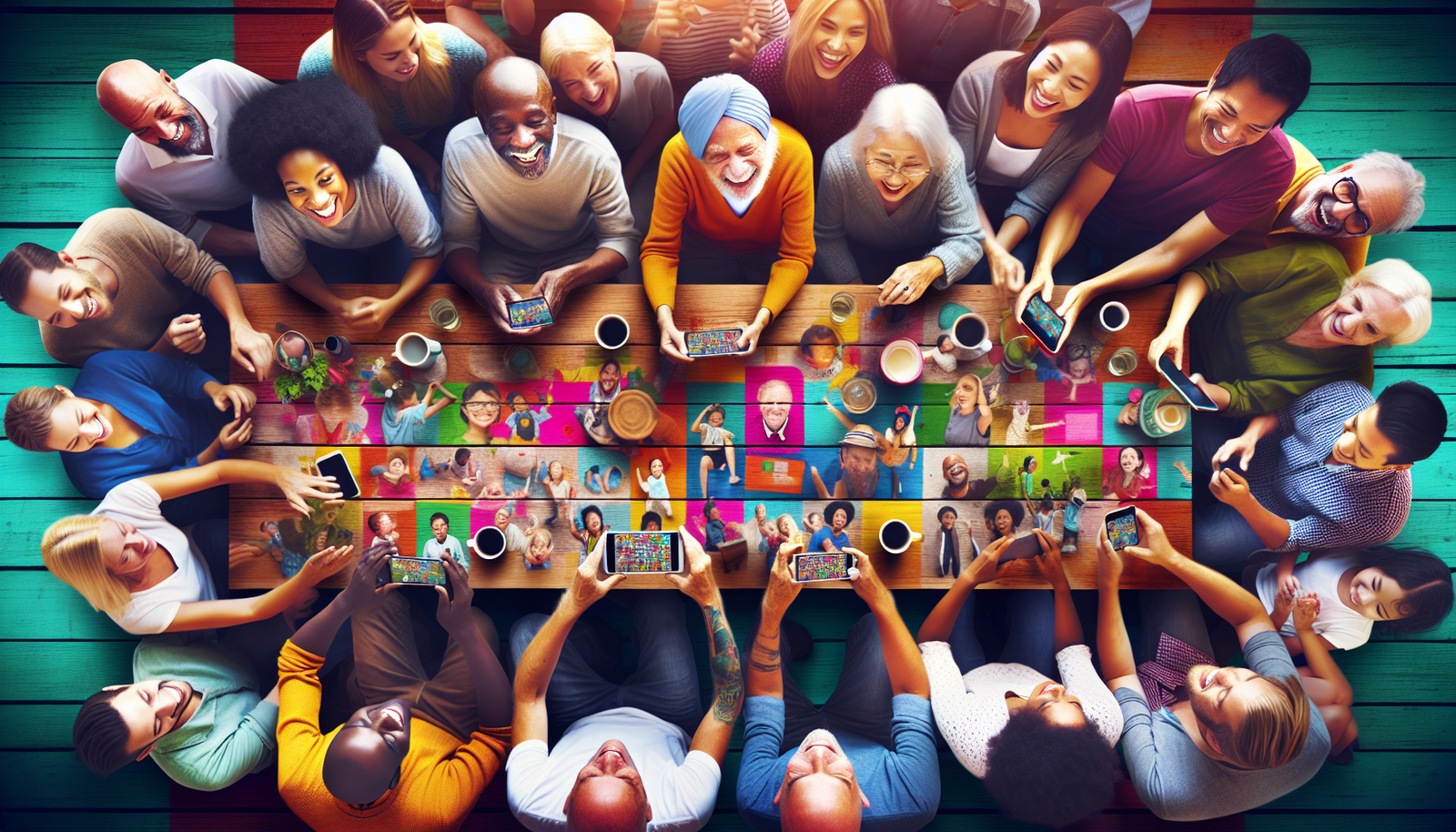User-generated Content Featuring The Product
You’ve probably noticed it before – photos, videos, and reviews shared by fellow users showcasing a product in action. It’s user-generated content featuring the product that captures the attention of potential buyers and influences their purchasing decisions. In this article, we’ll explore the power of user-generated content and how it plays a crucial role in building trust, sparking interest, and ultimately driving sales. Get ready to see firsthand how everyday users become brand ambassadors simply by sharing their authentic experiences.
Benefits of User-generated Content
User-generated content has become increasingly popular in recent years, and for good reason. There are several key benefits to incorporating user-generated content into your marketing strategy.
Enhances credibility
One of the major benefits of user-generated content is that it enhances the credibility of your brand. When potential customers see real people sharing their experiences with your product or service, it creates trust and authenticity. People are more likely to believe the opinions and recommendations of their peers than traditional marketing messages. User-generated content serves as social proof that your brand is reliable and trustworthy.
Increases engagement
User-generated content also has the power to significantly increase engagement with your audience. When users actively participate by creating and sharing content related to your brand, it creates a sense of community and encourages others to do the same. This type of engagement not only boosts brand awareness but also fosters a deeper connection between your brand and your customers. When users feel like they are part of a larger community, they are more likely to engage with your brand on a regular basis.
Adds authenticity
Authenticity is essential in today’s marketing landscape, and user-generated content brings an unparalleled level of authenticity to your brand. Rather than relying solely on carefully crafted marketing campaigns, user-generated content represents genuine experiences and opinions from real people. This authenticity builds trust with your audience and sets your brand apart from competitors who rely solely on traditional advertising methods. User-generated content allows your audience to see your brand in a more relatable and authentic light.
Different Types of User-generated Content
User-generated content can take many forms, all of which have their own unique benefits.
Reviews and testimonials
One of the most common types of user-generated content is reviews and testimonials. When customers share their positive experiences with your product or service, it serves as a powerful endorsement for your brand. Reviews and testimonials can be found on platforms like Google, Yelp, and social media sites, where potential customers can see the real-life experiences of others. These reviews not only validate your brand but also help potential customers make informed decisions about purchasing your product or service.
Social media posts
Another popular type of user-generated content is social media posts. Whether it’s a tweet, a Facebook status update, or an Instagram story, social media platforms offer users a way to share their experiences with your brand in real-time. Social media posts can include photos, videos, and captions that highlight the benefits and features of your product or service. This type of user-generated content not only boosts brand visibility but also encourages others to engage with your brand through likes, comments, and shares.
Photos and videos
Photos and videos are powerful forms of user-generated content as they provide a visual representation of your brand. When users share photos and videos of themselves using your product or service, it showcases the real-world application and benefits. These visuals can be shared on social media platforms, customer review websites, or even on your own website. Photos and videos not only capture the attention of potential customers but also serve as a creative and engaging way for users to share their experiences.
Tips for Encouraging User-generated Content
While user-generated content is valuable, it doesn’t just happen on its own. Here are several tips for encouraging your audience to create and share user-generated content.
Create a branded hashtag
One effective way to encourage user-generated content is by creating a branded hashtag. A branded hashtag is a unique hashtag specifically associated with your brand or a particular campaign. When users use this hashtag in their social media posts, it helps aggregate and categorize their content, making it easier for others to find and engage with. Branded hashtags also create a sense of community among users who share a common interest in your brand.
Offer incentives
People love incentives, and offering rewards or incentives can be a powerful motivator for users to create and share user-generated content. Consider running contests, giveaways, or loyalty programs that reward users for their participation. Whether it’s a discount on their next purchase, exclusive access to new products, or the chance to win a prize, incentives can significantly increase the amount of user-generated content your brand receives.
Engage with your audience
Engaging with your audience is key to encouraging user-generated content. Actively respond to comments, questions, and feedback from your audience. When users see that you value their opinions and appreciate their contributions, they will be more likely to engage with your brand and create user-generated content. Additionally, consider featuring user-generated content on your social media platforms or website. By showcasing and celebrating user contributions, you create a positive feedback loop that encourages even more engagement.
Best Practices for Sharing User-generated Content
Sharing user-generated content is not as simple as reposting or retweeting. To ensure the best results, it’s important to follow these best practices.
Seek permission from users
Before sharing user-generated content, it’s essential to seek permission from the individuals who created it. This not only respects the intellectual property rights of the content creators but also helps protect your brand from potential legal issues. Reach out to the users directly through direct messaging or email and request their permission to share their content. Most users will be flattered and happy to have their content featured by your brand.
Give proper credit
When sharing user-generated content, always give proper credit to the original content creator. This can be as simple as tagging their social media handle or mentioning their name in the caption or description. Properly crediting the content creator not only shows appreciation for their contribution but also builds goodwill and fosters a positive relationship between your brand and the user.
Moderate and filter content
While user-generated content can be a valuable marketing asset, it’s important to moderate and filter the content before sharing it. Some user-generated content may be inappropriate, offensive, or not in line with your brand values. Take the time to review and filter user-generated content to ensure it aligns with your brand image and resonates with your target audience. Additionally, monitoring and moderating user-generated content helps maintain a positive and safe online environment for your audience.
The Power of User-generated Content in Marketing
User-generated content has the power to significantly impact your marketing efforts in various ways.
Expands reach and visibility
By encouraging users to create and share content related to your brand, you can significantly expand your reach and visibility. When users share their experiences with your product or service, their network of friends and followers becomes exposed to your brand. This organic exposure can lead to increased brand awareness and reach among new audiences who may not have been previously familiar with your brand.
Boosts conversions
User-generated content has been shown to have a positive impact on conversions. When potential customers see real people sharing their positive experiences with your product or service, they are more likely to trust and feel confident in making a purchase. User-generated content serves as social proof that your product or service delivers on its promises, thus increasing the likelihood of conversions and sales.
Creates loyal brand advocates
User-generated content has the unique ability to turn customers into loyal brand advocates. When users actively participate in creating and sharing content related to your brand, they develop a deeper connection and sense of ownership. These loyal brand advocates not only continue to engage with your brand but also actively promote it to their network. Their authentic and passionate advocacy can lead to increased brand loyalty and long-term customer relationships.
Case Studies: Successful User-generated Content Campaigns
Several brands have successfully incorporated user-generated content into their marketing campaigns, resulting in significant success. Here are a few notable examples:
Coca-Cola’s ‘Share a Coke’ campaign
Coca-Cola’s ‘Share a Coke’ campaign is a prime example of the power of user-generated content. The campaign encouraged customers to find Coca-Cola bottles and cans with names or personalized messages and share them on social media using the hashtag #ShareACoke. This campaign not only generated a massive amount of user-generated content but also created a sense of personal connection and nostalgia among consumers. The campaign’s success was driven by the emotional appeal of personalization and the desire for consumers to share their unique Coca-Cola experiences.
GoPro’s customer-created videos
GoPro has built its brand around user-generated content by encouraging customers to create and share videos of their adventures using GoPro cameras. By showcasing the incredible footage captured by their customers, GoPro has grown into a global phenomenon. The brand has even sponsored contests and events that incentivize users to submit their videos, resulting in a vast library of incredible user-generated content. GoPro’s success lies in its ability to tap into the passions and adventures of its customers, creating a community of content creators that continually promote the brand.
Starbucks’ White Cup Contest
Starbucks’ White Cup Contest is another successful user-generated content campaign. The contest invited customers to decorate their Starbucks cups and share their designs on social media using the hashtag #WhiteCupContest. Thousands of customers participated, creating unique and artistic designs that showcased their creativity. Starbucks selected a winning design to be featured as a limited edition cup, which further incentivized customers to participate. This campaign not only generated an enormous amount of user-generated content but also fostered creativity and engagement among Starbucks customers.
Risks and Challenges of User-generated Content
While user-generated content offers many benefits, there are also risks and challenges involved.
Negative or inappropriate content
One of the main risks of user-generated content is the potential for negative or inappropriate content. When users are given the freedom to create and share content, there is a possibility that some of it may not align with your brand values or may be offensive to others. It’s essential to have systems in place to moderate and filter user-generated content to ensure it meets your brand standards and maintains a positive online environment.
Legal issues and copyright infringements
Another challenge of user-generated content is the potential for legal issues and copyright infringements. When users create and share content, they may unknowingly violate copyright laws or use intellectual property owned by others without permission. It’s crucial to have clear guidelines and policies in place regarding the use of copyrighted material and intellectual property to protect your brand from potential legal consequences.
Lack of control over the content
User-generated content also poses the challenge of limited control over the content. Because users create and share the content, it can be challenging to steer the narrative or ensure consistency in messaging. While this lack of control can be a risk, it can also be an opportunity for genuine and authentic content. Establishing clear guidelines and fostering an engaged community can help mitigate this challenge.
Tools and Platforms for Managing User-generated Content
To effectively manage user-generated content, there are several tools and platforms available to simplify the process.
Social media management tools
Social media management tools like Hootsuite, Sprout Social, and Buffer can help streamline the process of managing and monitoring user-generated content. These tools allow you to schedule and publish content, track engagement, and monitor brand mentions and hashtags. They provide a centralized platform to keep track of user-generated content across various social media channels.
Content moderation platforms
Content moderation platforms such as BrandBlox and Community Sift can help automate the moderation and filtering of user-generated content. These platforms use machine learning and artificial intelligence algorithms to identify and remove inappropriate or offensive content. By automating the moderation process, brands can save time and ensure that only appropriate user-generated content is shared.
Hashtag tracking tools
Hashtag tracking tools like Hashtagify and RiteTag can help monitor the performance and reach of branded hashtags. These tools provide insights into the popularity and usage of specific hashtags, helping brands track and analyze the impact of user-generated content campaigns. By monitoring hashtag usage, brands can gain valuable data and insights to inform their marketing strategies.
Measuring the Impact of User-generated Content
To measure the impact of user-generated content, it’s important to track and analyze relevant metrics.
Social media metrics
When it comes to user-generated content on social media, metrics like engagement rate (likes, comments, shares), reach, and sentiment analysis are key indicators of impact. These metrics provide insights into the level of audience engagement and sentiment towards the user-generated content. Additionally, tracking the growth of followers, mentions, and branded hashtags can help gauge the overall impact of user-generated content on social media platforms.
Website analytics
Website analytics can also provide valuable insights into the impact of user-generated content. By tracking metrics such as website traffic, time on page, and conversion rates, brands can assess the influence of user-generated content on driving website visits and conversions. Additionally, setting up event tracking and conversion goals can help attribute specific actions or purchases to user-generated content.
Customer surveys
Conducting customer surveys can provide direct feedback and insights into the impact of user-generated content. By asking specific questions related to user-generated content, brands can gather qualitative data on customer perceptions and behaviors. Surveys can help uncover the influence of user-generated content on brand awareness, consideration, and purchase decisions.
Future Trends in User-generated Content
As technology continues to evolve, user-generated content is expected to evolve as well. Here are a few future trends to keep an eye on:
Live streaming and video content
Live streaming and video content are expected to play an even more significant role in user-generated content. As technology improves and becomes more accessible, users are increasingly adopting live streaming platforms like YouTube Live and Facebook Live to share their experiences in real-time. Video content provides a highly engaging and immersive way for users to showcase their interactions with a brand and is likely to continue growing in popularity.
Augmented reality experiences
With the advancement of augmented reality (AR) technology, user-generated content is likely to incorporate AR experiences. AR allows users to overlay virtual elements onto the real world, creating interactive and personalized experiences. Brands can leverage AR to encourage users to create and share user-generated content featuring AR filters, effects, or virtual brand integrations.
Incorporating AI for content curation
Artificial intelligence (AI) is expected to play a significant role in the curation of user-generated content. AI algorithms can automatically identify and filter user-generated content based on specific criteria or guidelines set by the brand. This automation can streamline the content curation process, making it more efficient and effective. Additionally, AI can help uncover patterns and trends within user-generated content, providing valuable insights for marketing strategies.
In conclusion, user-generated content offers numerous benefits for brands, including enhanced credibility, increased engagement, and added authenticity. By utilizing various types of user-generated content such as reviews, social media posts, and photos/videos, brands can tap into the creativity and experiences of their customers. To encourage user-generated content, brands can create branded hashtags, offer incentives, and actively engage with their audience. It’s important to follow best practices for sharing user-generated content, including seeking permission, giving proper credit, and moderating and filtering the content. User-generated content has the power to expand brand reach, boost conversions, and create loyal brand advocates. By learning from successful campaigns like Coca-Cola’s ‘Share a Coke,’ GoPro’s customer-created videos, and Starbucks’ White Cup Contest, brands can leverage the power of user-generated content effectively. However, there are risks and challenges involved, such as negative/inappropriate content, legal issues, and lack of control. Utilizing tools and platforms like social media management tools, content moderation platforms, and hashtag tracking tools can help manage user-generated content. Measuring the impact of user-generated content can be done by analyzing social media metrics, website analytics, and conducting customer surveys. Looking ahead, future trends in user-generated content include live streaming/video content, augmented reality experiences, and incorporating AI for content curation. By staying ahead of these trends, brands can continue to leverage user-generated content to drive their marketing efforts forward.




